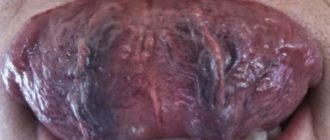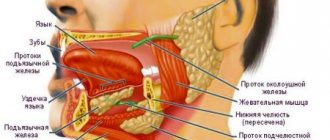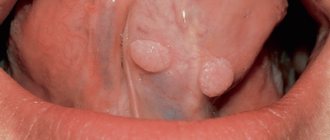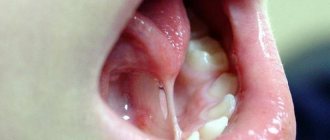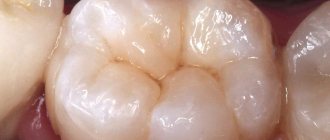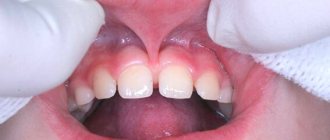Pain under the tongue can serve as one of the main symptoms of a whole range of problems, from banal mechanical injuries to a number of pathologies of the oral cavity, nervous system or internal organs. Depending on the cause and location of the pain, it can have a different nature and intensity.
If you or your loved one has pain under the tongue, there is no need to panic or self-medicate - this can only lead to aggravation of the situation. Contact a dentist at a dental clinic, he will conduct a diagnosis, determine the exact cause of the discomfort and prescribe an adequate treatment regimen to effectively eliminate the pain.
What is in the sublingual area
The tissues located on the lower jaw under the tongue are called the floor of the mouth. Due to the complexity of the structure, as well as the natural functionality of this area, a person often experiences problems accompanied by pain.
Structure of the sublingual region:
- Hyoid muscles - have an elastic structure and are responsible for the motor function of the area;
- Hyoid bone - has an anatomical shape in the form of a horseshoe, located in the muscle layer. It is the only bone in the human body that has no connections with other bones of the body;
- Nerve endings are elements of the peripheral nervous system, responsible for the sensitivity of the sublingual area to various physical, mechanical and thermal stimuli;
- Salivary glands - responsible for the production of saliva, which is involved in the process of wetting the mucous membranes of the oral cavity and the digestion process;
- Blood vessels - provide nutrition to the tissues of the sublingual area;
- Frenules are connecting folds in the sublingual area, responsible for connecting the sublingual tissues with the tongue.
Each of the above elements ensures the natural functionality of the dentofacial apparatus and participates in all physiological processes of the oral cavity.
What to do at home if a growth appears - folk methods
In addition to traditional treatment of growths under the tongue, many patients use traditional recipes. It is impossible to replace treatment with a completely unconventional method, but nothing prevents you from trying it.
Popular folk recipes for growths under the tongue:
- daily rubbing of the formations with garlic juice or applying cloves of spice;
- lubricating newly appeared growths with egg white;
- treating affected areas with castor oil (using cotton swabs);
- rinse the mouth twice a day with decoctions of medicinal herbs (medicinal chamomile, string, sage, echinacea, etc.);
- ingesting rosehip decoction, freshly squeezed potato or carrot juice.
Any infections and viruses developing in the body signal a decrease in immunity, so during the treatment period you should take care of taking fresh vegetables and fruits. A good vitamin complex is also suitable for these purposes.
Before using an unconventional approach, you should consult your doctor to rule out contraindications.
Causes of pain under the tongue
Modern medicine knows dozens of different reasons that can cause unpleasant and painful sensations under the tongue in an adult, teenager and child: from a banal mechanical injury to the frenulum, leading to tissue damage, to allergic reactions causing swelling. At the same time, there is a list of the most common causes observed in most patients.
The main causes of pain under the tongue:
- Mechanical injuries to the frenulum and muscle tissue are the most common cause of sublingual pain. As a rule, it is observed in people with a short frenulum. It is injured due to stretching, as well as in the event of mechanical trauma to tissues, for example, during eating, hygienic brushing of teeth, etc.;
- Dental pathologies of the oral cavity – stomatitis, dental problems (caries, periodontitis, periodontitis), gumboil, etc.;
- Infectious inflammation of the oral cavity - pain often manifests itself with sore throat. During this period, it is painful for a person to eat, swallow water and saliva, stick out his tongue or simply chew;
- Cellulitis or abscess of the floor of the mouth is a significant accumulation of pus in a small area of the floor of the mouth. Causes “bursting” of internal tissues, putting pressure on peripheral nerves - this provokes pain and tactile discomfort;
- An allergic reaction can be the body’s response to various irritants. Causes swelling of the soft tissues of the oral cavity, accompanied by discomfort or pain in the sublingual area;
- Asymmetry of the hyoid bone - an anatomical disorder in the growth of the hyoid bone, can provoke excessive or nonspecific pressure on the peripheral nerves, causing pain;
- Neuralgia is a general disease of the nervous system that manifests itself in its various parts. It is often a consequence of nervous shock and is accompanied by a feeling of painful numbness in the oral cavity;
- Diseases of internal organs and body systems - some areas of the tongue may reflect (irradiate) pathologies of internal organs, which is accompanied by painful sensations in the sublingual area;
Note! Most of the above problems that provoke the development of pain in the sublingual area can be caused by bacterial infections (streptococci), fungi (candidiasis), and herpes.
As a conclusion
You should not self-medicate if the situation gets out of control. At the slightest change in the condition of the tongue and mucous membranes, it is best to go to the hospital.
If the disease is chronic, such as a stomach ulcer, then to avoid complications you should take medications prescribed by your doctor and also follow a diet.
The tongue is an organ in the mouth that consists almost entirely of muscle tissue. Part of its surface contains taste buds, and it performs important functions in chewing, swallowing and speaking. Swelling of the tongue is a pathology in which its volume begins to exceed its standard dimensions.
If the swelling occurs instantly, it may be a sign of an acute anaphylactic reaction. Otherwise, there are a number of other factors, from illness to injury, that could cause a swollen tongue.
Symptomatic features of pain under the tongue
Pain in the sublingual area can have various symptomatic manifestations. First of all, they are accompanied by different types of pain (sharp, aching, throbbing), as well as constancy or frequency.
If you consult a doctor, it is very important to correctly characterize the pain - this will allow the specialist to narrow down the range of symptoms for differential diagnosis. For example, you may have pain in the frenulum under your tongue or pain under your tongue on the right/left.
One of the characteristic manifestations of stomatitis or candidiasis is a white pimple under the tongue. Its presence may indicate the development of a fungal or bacterial process. If such a symptom is detected, treatment will include antifungal and antibacterial therapy with the prescription of antibiotics or special antiseptic rinses. The presence of pimples of a different color may indicate the presence of a wide range of problems, the identification of which requires a thorough diagnosis of the oral cavity or the entire body.
Symptoms
You can recognize a problem in the oral cavity by the following signs:
- seals, tubercles, small antennae or outgrowths form under the tongue, which are clearly visible upon visual inspection;
- the shape of the formation is filamentous or elliptical;
- the texture is soft and smooth, no peeling is observed;
- the color of the growth may be the same as the mucous membrane, or have a reddish, whitish tint;
- the formation is 2-20 mm in diameter.
Features of diagnosis and treatment of pain under the tongue
Treatment of pain in the sublingual area should be carried out after a high-quality diagnosis to determine the root cause of the problem. Sometimes, pain in the frenulum under the tongue or in the surrounding tissues is treated by therapists or allergists, but in most cases this is done by dentists, because about 90% of all cases of treatment are associated with a dental problem.
Diagnosis of pain under the tongue is carried out in several stages:
- Initial appointment - the doctor collects anamnesis, finds out information about the nature and location of pain, and also examines the patient’s oral cavity;
- A complete diagnostic examination is carried out in the absence of characteristic symptoms of common dental diseases. It is possible to use hardware techniques (X-ray, ultrasound, MRI, etc.);
- Differential diagnosis – a specialist differentiates the underlying pathology from similar diseases;
- Making a diagnosis and prescribing treatment - based on the data of the initial examination and diagnosis, the doctor establishes an accurate diagnosis and prescribes an adequate treatment regimen.
Note! The method of treatment and the choice of drugs to eliminate pain in the sublingual area directly depend on the root cause of the symptoms. For example, if your frenulum hurts due to a mechanical injury, antiseptic and anti-inflammatory solutions for mouth rinsing will be prescribed, including: chlorophyllipt, hexoral, stomatophyte, alcohol tincture of calamus, stomatidine or others. If the pain is associated with the development of bacteria or fungi, antibacterial, antifungal and anti-inflammatory therapy is prescribed.
How not to miss such inflammation?
The first alarming signal is the appearance of obvious swelling in the area where the salivary gland is located. It becomes painful almost immediately. This area quickly becomes inflamed, the skin above it becomes shiny, red and tense, and acquires excessive elasticity. In the mouth, where the exit of the duct of this gland is located, swelling and inflammation begin to develop. This zone is clearly defined and difficult to miss. Cloudy saliva begins to be released from the duct, and in the most advanced cases, pus. The temperature rises sharply. It can rise to 39 degrees. The patient's condition deteriorates very quickly. New alarming symptoms appear every day. Swelling increases rapidly. Soon the patient may even have problems opening his mouth because of it. The pain syndrome is growing. At this stage, it is extremely important to take appropriate comprehensive treatment. If it is absent, serious complications develop due to the fact that pathological processes worsen. If enough time has passed since the inflammation process began, and treatment has not been prescribed, then dangerous complications may arise. For example, salivary fistulas.
To avoid inflammation, it is important to take timely care of high-quality prevention. Good oral hygiene is very important. You should take good care of your oral cavity. Brush your teeth thoroughly twice a day, rinse your mouth with special balms. If you notice that saliva flow from the ducts has become worse, use special medications that promote its outflow. It is useful to wipe the mouth with a solution of citric acid (1%). A special kind of food will also help. If everything is fine with your gastrointestinal tract, you can consume more spices and juice products. This special diet perfectly stimulates saliva production.
Also, for patients who have impaired salivation, doctors recommend taking a saline solution of pilocarpine (about 6 drops) every day (3-4 times). It can be replaced with potassium iodide (2%). You need to take it 1 tablespoon 2-3 times a day. If a diagnosis of “inflammation of the salivary gland” has been made, the doctor will immediately need to prescribe effective antibacterial treatment. The inflamed area of the gland can be injected around with a solution of novocaine (0.5%). This blockade is quite effective. Antibiotics are prescribed intramuscularly.
To support such therapy, the doctor also prescribes a number of physiotherapeutic procedures to the patient. If purulent foci appear, surgical intervention will be necessary. There is no need to be afraid of such an operation. Remember that the inflammatory process in the salivary glands is much more dangerous than surgery. The surgeon will only free the cavity from accumulated pus. This will immediately bring relief, relieve pain, and your general condition will noticeably improve.
It also happens that the duct of the salivary gland closes the stone. In this case, you need to remove it as soon as possible. Doctors call this pathology sialolithiasis. As it develops, stones begin to form in the ducts or parenchyma of the gland itself. Most often they are single, but in some cases the formation of a whole group can be observed. Their sizes can be completely different - from a small grain of sand to a stone the size of a chicken egg. The reason for this striking pathology lies in a violation of mineral metabolism.
Sialolithiasis does not make itself felt immediately. The person feels quite healthy, but tiny stones are already beginning to form in the ducts, which can soon block them. It is at the moment when the normal outflow of fluid stops that a person begins to feel the symptoms of the disease. They begin with a sharp pain, which has the character of colic. Further, in the place where the pain syndrome appears, swelling and edema forms. Such symptoms may periodically subside and then intensify again.
The inflammation process progresses rapidly. As the disease progresses, its manifestations become stronger. The main key to successful treatment is the removal of the culprit of the disease - a stone or a group of stones at once. If the process has gone too far and the stones themselves cannot be removed, the entire salivary gland must be removed. The salivary gland under the tongue does not often become inflamed. But if such inflammation occurs, it makes itself felt with bright and rapidly developing clinical manifestations. If this pathology is not treated, the consequences can be disastrous.
The tongue itches - what to do if the organ literally itches
The tongue can itch not only in a figurative sense. If you experience unpleasant irritating sensations, the first thing you should do is figure out what could be the reason for the appearance of this symptom. The organ is a muscle containing a huge number of nerves and blood vessels. The occurrence of discomfort, burning, soreness, swelling and itching in the tongue always indicates some pathological condition, and the symptom itself may be associated with dental disease and disturbances in the functioning of internal organs.
Why might my tongue itch?
In any case, if this symptom develops, you should immediately see a specialist. Further in this article we will find out why the tongue may itch, what preconditions contribute to this, and what to do in such a situation.
Avitaminosis
Often the frenulum hurts due to vitamin deficiency - a long-term lack of vitamins in the body, from which not a single person is immune.
© shutterstock
The cause of vitamin deficiency, which causes various pains, is:
- Unbalanced diet;
- Problems with the gastrointestinal tract;
- Violation of metabolic processes;
- Medicines for weight loss;
- Long-term use of certain medications;
- Dysbacteriosis.
Signs of illness
Vitamin deficiency manifests itself:
- Frequent illnesses;
- Pain in the limbs;
- Lack of appetite;
- Weight loss;
- Poor concentration;
- Increased bleeding.
Treatment options
To cure the disease, you should take a vitamin complex prescribed by your doctor.
How to treat
Modern methods of treating varicose veins can be divided into medicinal and surgical. The former are used to slow down and stop the course of the disease in the initial stages, from initial manifestations to stage 2 disease.
Surgery is a panacea for advanced disease. However, it is the latter that has the most pronounced result and allows you to get rid of not only the cosmetic problem, but also the possible development of complications caused by this pathology.
The choice of the necessary treatment method is the prerogative of the attending physician alone, who can correctly assess the patient’s condition.
Conservative therapy involves taking medications with various pharmacological effects, namely venotonics, anticoagulants, antiplatelet drugs . Some of them come in various forms and are used both internally and topically.
Blue swollen veins that appear under the tongue, photos of which can often be seen on the Internet, can be treated surgically or by injecting a sclerosing substance into the venous cavity, causing it to stick together.
Veins are removed by microphlebectomy or laser coagulation. Any of these techniques is aimed at restoring proper blood circulation. We described in our material how varicocele manifests itself and is treated in adolescents.
Therapeutic measures – complex treatment
In order to get rid of an annoying symptom once and for all, you first need to identify its root cause, and it is this that needs to be treated. Medications may be prescribed as symptomatic therapy. Typically, complex treatment involves taking antihistamines, antipsychotics, immunostimulants and anti-inflammatory drugs. If the patient has a deficiency of beneficial vitamins and microelements, additional multivitamin complexes may be prescribed to strengthen the body's defenses.
Only a specialist can prescribe the correct treatment
If oral candidiasis is to blame, a specialist may prescribe antifungal agents. It is also mandatory to carry out complete sanitation of the oral cavity in order to eliminate any provoking factors. Other methods of relieving acute symptoms include all kinds of baths and applications using medicinal herbs: wheat germ, rose hips, sea buckthorn oil and others. In this regard, rinsing with a soda solution has worked well - one tablespoon per glass of water. However, it should be understood here that the use of any traditional medicine must first be agreed with the attending physician.
